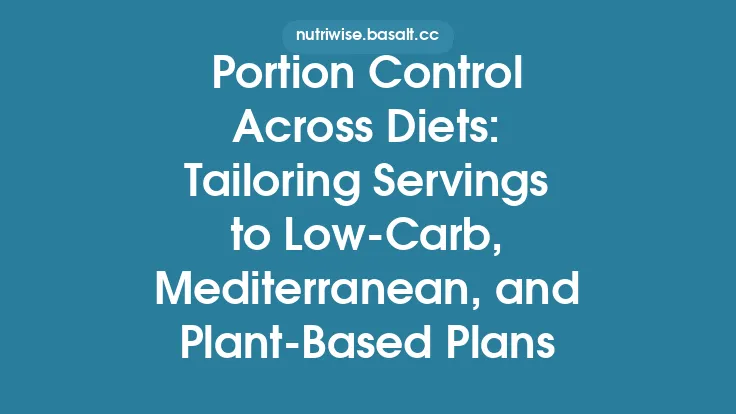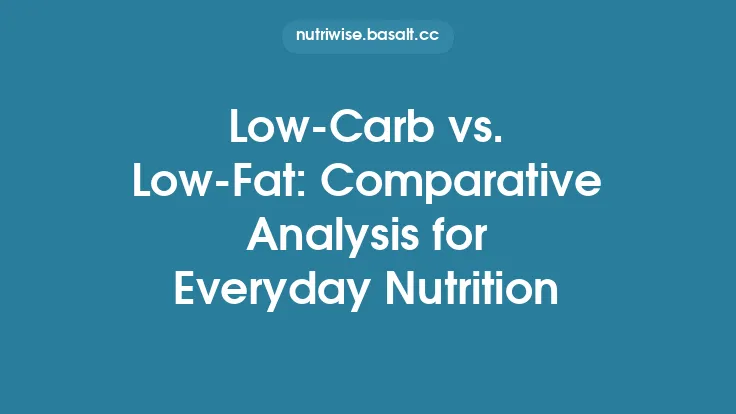Batch cooking high‑protein, low‑carb soups is an especially effective strategy for anyone who needs to keep blood glucose levels steady throughout the day. Soups are naturally hydrating, easy to digest, and can be packed with lean proteins, non‑starchy vegetables, and healthy fats—all of which blunt post‑meal glucose spikes. By preparing large batches in advance, you eliminate the temptation to reach for quick, high‑glycemic convenience foods, and you gain precise control over the macronutrient profile of each serving.
Why Soups Are a Glucose‑Friendly Choice
Slow Digestion and Satiety
Protein and fiber both delay gastric emptying, which translates into a slower release of glucose into the bloodstream. A well‑balanced soup that contains at least 15–20 g of protein per serving and a generous amount of soluble fiber can keep blood sugar from soaring for up to three hours after the meal.
Thermic Effect of Food (TEF)
Protein has the highest thermic effect of any macronutrient—about 20‑30 % of its calories are expended during digestion, absorption, and metabolism. This extra energy expenditure helps blunt the net rise in blood glucose after eating.
Low Glycemic Load (GL)
Even if a soup contains a small amount of carbohydrate, the overall glycemic load can remain low when the carbs are paired with protein and fat. The GL is calculated as:
\[
\text{GL} = \frac{\text{GI} \times \text{available carbs (g)}}{100}
\]
A GL < 10 per serving is generally considered low and is ideal for glucose stability.
Selecting High‑Quality Protein Sources
| Protein Type | Typical Serving (g) | Net Carbs (g) | Key Benefits for Glucose Control |
|---|---|---|---|
| Skinless chicken breast | 100 | 0 | Lean, high‑biological‑value protein |
| Turkey thigh (skin removed) | 100 | 0 | Slightly higher fat for satiety |
| Grass‑fed beef (lean cuts) | 100 | 0 | Rich in iron and zinc |
| Wild‑caught fish (salmon, cod) | 100 | 0 | Omega‑3s improve insulin sensitivity |
| Tofu (firm) | 150 | 2 | Plant‑based, contains isoflavones |
| Tempeh | 100 | 5 | Fermented, adds probiotic benefits |
| Low‑fat Greek yogurt (plain) | 150 | 4 | Adds creaminess and calcium |
| Egg whites (or whole eggs) | 3 large eggs | 0.6 | High‑quality protein, minimal carbs |
When batch‑cooking, combine two or more protein sources for texture variety and a broader amino‑acid profile. For example, a chicken‑and‑turkey blend or a fish‑tofu mix can keep the palate interested while maintaining a low net‑carb count.
Building a Low‑Carb Soup Base
Broths vs. Stock
- Clear broths (chicken, beef, vegetable) are naturally low in carbs (< 1 g per cup) and provide a clean canvas for flavors.
- Bone‑based stocks contain gelatin, which may improve gut health and slow carbohydrate absorption by forming a viscous layer in the stomach.
Non‑Starchy Vegetables
Choose vegetables that contribute fiber without adding significant carbs:
| Vegetable | Net Carbs (per 100 g) | Fiber (g) | Typical Use |
|---|---|---|---|
| Spinach | 1.4 | 2.2 | Leafy base, added at the end |
| Zucchini | 2.1 | 1.0 | Diced or spiralized for texture |
| Bell peppers | 2.9 | 1.5 | Sweetness without sugar |
| Mushrooms | 2.3 | 1.0 | Umami depth |
| Celery | 1.4 | 1.6 | Aromatic foundation |
| Green beans | 3.6 | 3.4 | Crunchy bite |
Healthy Fats for Glucose Modulation
A modest amount of fat (1–2 tsp per serving) can further blunt glucose spikes. Options include:
- Extra‑virgin olive oil (drizzle before serving)
- Avocado oil (added during cooking)
- Coconut milk (full‑fat, unsweetened) – use sparingly for a creamy texture
Flavor Development Without High‑GI Additives
- Aromatic Foundations – Sauté onions, garlic, and ginger in a small amount of oil at the start. Even though sautéing is a cooking technique, the focus here is on flavor, not fiber preservation. Keep the quantity low to avoid excess carbs.
- Herb & Spice Layers – Bay leaves, thyme, rosemary, smoked paprika, cumin, and turmeric add depth without carbs. Turmeric also has anti‑inflammatory properties that may improve insulin sensitivity.
- Acid Balance – A splash of apple cider vinegar or lemon juice at the end of cooking can lower the soup’s glycemic impact by slowing gastric emptying. This is distinct from “acidic marinades” discussed in other articles.
- Umami Boosters – A teaspoon of nutritional yeast, tamari (gluten‑free soy sauce), or Miso paste (use low‑sodium, low‑sugar varieties) adds savory richness without raising the GL.
Batch‑Cooking Workflow
1. Planning the Batch Size
- Standard serving: 1 ½ cups (≈ 350 ml)
- Batch target: 8–10 servings (≈ 12 cups) – fits comfortably in a 6‑quart stockpot or a 5‑liter slow cooker.
2. Ingredient Pre‑Prep
- Protein: Cut into uniform 1‑inch cubes for even cooking.
- Vegetables: Dice or slice to similar size; consider blanching tougher greens (e.g., kale) for 2 minutes to preserve color and texture.
- Spice Mix: Combine dry spices in a small bowl; this ensures even distribution.
3. Cooking Sequence
| Step | Action | Approx. Time |
|---|---|---|
| 1 | Heat 1 tbsp oil; add aromatics (onion, garlic, ginger) until translucent | 3–4 min |
| 2 | Add protein; brown lightly (optional, for flavor) | 4–5 min |
| 3 | Pour in broth/stock; bring to a gentle boil | 5 min |
| 4 | Add low‑carb vegetables and spices; reduce to simmer | 10–15 min |
| 5 | Finish with healthy fats and acid (oil, vinegar) | 1 min |
| 6 | Cool rapidly (ice‑water bath) before portioning | 5 min |
4. Cooling & Portioning
- Rapid cooling prevents bacterial growth. Submerge the pot in an ice‑water bath, stirring occasionally.
- Portion into 1 ½‑cup (350 ml) containers. Use BPA‑free plastic or glass jars with tight‑fitting lids.
5. Labeling
- Include date, protein source, and net carbs per serving. This aids tracking and ensures you rotate older batches first.
Storage, Reheating, and Shelf Life
| Storage Method | Temperature | Shelf Life | Reheating Tips |
|---|---|---|---|
| Refrigerator | ≤ 4 °C | 4–5 days | Heat gently on stovetop; avoid boiling to preserve protein quality |
| Freezer (solid) | ≤ ‑18 °C | 2–3 months | Thaw overnight in fridge; reheat in microwave or saucepan, adding a splash of broth if viscosity is high |
| Vacuum‑sealed bag (portion) | ≤ ‑18 °C | 3–4 months | Directly submerge bag in simmering water; no need to open until serving |
Avoid reheating soups more than twice, as repeated heating can degrade heat‑sensitive nutrients (e.g., vitamin C) and affect texture.
Portion Control and Meal Planning
- Macro Target per Serving: 20–25 g protein, ≤ 8 g net carbs, 5–7 g fat.
- Pairing: Combine a soup serving with a small side of raw nuts (≈ 10 g) or a leafy salad dressed with olive oil for extra satiety.
- Timing: Consume the soup as a mid‑morning snack or pre‑exercise meal to provide a steady glucose supply without a spike.
Use a simple spreadsheet to log each batch’s nutritional breakdown. This makes it easy to adjust future batches—e.g., increase protein by 5 g if you notice post‑meal glucose creeping upward.
Customizing for Specific Dietary Needs
| Need | Adjustments |
|---|---|
| Ketogenic | Keep total carbs ≤ 5 g per serving; replace any higher‑carb veg (e.g., carrots) with extra leafy greens or cauliflower rice. |
| Dairy‑Free | Omit Greek yogurt; use coconut cream (unsweetened) for creaminess. |
| Vegetarian | Substitute animal protein with tempeh, tofu, or a blend of legumes (e.g., black soybeans) that have a low net carb count. |
| Low‑Sodium | Use homemade broth without added salt; season with herbs, spices, and a pinch of potassium chloride (salt substitute). |
| Allergen‑Sensitive | Avoid soy‑based proteins if allergic; opt for egg whites, fish, or meat. |
Troubleshooting Common Issues
| Problem | Likely Cause | Solution |
|---|---|---|
| Soup is too thin | Insufficient vegetables or protein; too much broth | Blend a portion of the soup with an immersion blender, or add cauliflower florets and re‑blend. |
| Soup is too salty | Store‑bought broth high in sodium | Dilute with water and add a splash of lemon juice to brighten flavor. |
| Protein clumps after reheating | Over‑cooking protein or rapid temperature change | Reheat slowly over low heat, stirring frequently; add a splash of broth to loosen. |
| Texture changes (e.g., mushy veg) | Over‑cooking during batch | Reduce simmer time; add heartier veg (e.g., broccoli stems) later in the cooking cycle. |
| Unexpected glucose rise after a serving | Hidden carbs (e.g., sweetened tomato paste) | Use unsweetened tomato puree or omit tomatoes; verify net carb counts of all ingredients. |
The Science Behind Consistent Glucose Control
- Protein‑Induced Gluconeogenesis – While protein can be converted to glucose, the process is slow and does not cause rapid spikes. The liver releases glucose gradually, aligning with the body’s basal needs.
- Fiber’s Role – Soluble fiber (e.g., from zucchini, mushrooms) forms a gel in the gut, slowing carbohydrate absorption and blunting post‑prandial glucose peaks.
- Fat‑Mediated Gastric Emptying – Adding 5–10 g of monounsaturated fat delays stomach emptying by 30–45 minutes, flattening the glucose curve.
- Thermal Processing – Gentle simmering preserves the structural integrity of proteins and prevents the formation of advanced glycation end‑products (AGEs), which have been linked to insulin resistance.
Understanding these mechanisms helps you fine‑tune each batch for optimal metabolic outcomes.
Final Thoughts
Batch‑cooking high‑protein, low‑carb soups is more than a convenience hack; it is a deliberate, evidence‑based approach to stabilizing blood glucose. By selecting lean proteins, low‑glycemic vegetables, and healthy fats, and by mastering storage and reheating techniques, you create a reliable “glucose‑friendly pantry” that supports consistent energy levels, satiety, and long‑term metabolic health.
Make a habit of reviewing your blood glucose data after each soup‑based meal, and let those numbers guide incremental tweaks—whether that means adding a touch more fiber, swapping a protein source, or adjusting the fat ratio. Over time, this systematic, batch‑cooking strategy becomes a cornerstone of a sustainable, blood‑sugar‑friendly lifestyle.





